Aug 3, 2012 | coins, commemorative, legislative
 The White House announced today that President Obama signed the National Baseball Hall of Fame Commemorative Coin Act into law (H.R. 2527). The law calls for the U.S. Mint to commemorate the the National Baseball Hall of Fame in Cooperstown, New York with a three-coin commemorative program consisting of a $5 gold coin (50,000 maximum mintage), $1 silver coin (400,000 maximum), and a clad half-dollar (750,000 maximum) struck as uncirculated coins or as proofs.
The White House announced today that President Obama signed the National Baseball Hall of Fame Commemorative Coin Act into law (H.R. 2527). The law calls for the U.S. Mint to commemorate the the National Baseball Hall of Fame in Cooperstown, New York with a three-coin commemorative program consisting of a $5 gold coin (50,000 maximum mintage), $1 silver coin (400,000 maximum), and a clad half-dollar (750,000 maximum) struck as uncirculated coins or as proofs.
The bill requires an open competition for a common obverse design “emblematic of the game of baseball” with a $5,000 minimum prize for the winning design. The common reverse will “depict a baseball similar to those used by Major League Baseball.”
Surcharges will be $35 per gold coin, $10 per silver coin, and $5 for the clad half-dollar to be paid to the National Baseball Hall of Fame for their continuing operations. If all the coins sell out, the Hall of Fame will receive $9.5 million for ongoing operations.
The bill was sent to the White House on July 25, 2012 and was signed today.
National Baseball Hall of Fame logo courtesy of the National Baseball Hall of Fame.
Jul 15, 2012 | commemorative, foreign, history, US Mint
For over 80 years since its founding, the U.S. Mint worked to increase production for it to be the sole supplier of coins for the young country. During that time, foreign coins, specifically the Spanish Milled Dollar (8 Real silver coin) was legal tender and served daily commerce. Congress revoked their legal tender status with the passage of the Coinage Act of 1857 making the U.S. Mint the sole supplier of coins in the United States.
Although the U.S. Mint was supposed to be building to supply the country with coins, it was taking on contract minting since it was the only entity with the ability to strike high quality medals. The first record of producing medals for someone other than the government was in 1833 for the American Colonization Society, a group whose purpose was to transport free-born blacks and emancipated slaves back to Africa and settle what today is known as Liberia.
Congress authorized the U.S. Mint to strike circulating coinage for foreign governments with the passage of the Act of January 29, 1874, “Provided, That the manufacture of such coin shall not interfere with the required coinage of the United States.”
The first legal tender coins produced for a foreign government was struck at Philadelphia for the Venezuelan government in 1875-1876 dated 1876-1877. The last circulating foreign coins were struck for Panama in 1983 when congress revoked the authorization because it began to interfere with domestic coin production.
The last time a coin was struck for a foreign country was in 2000 when the Leif Ericson commemorative silver coins were produced for domestic sales and for Iceland. The Iceland coin was struck with a face value of 1,000 Krónur.
Between the first coins struck for Venezuela and the Leif Ericson Commemorative Coin for Iceland, the U.S. Mint produced 1,127 coin types, not including varieties, for 43 countries. Coins were produced in gold, varied fineness of silver, bronze, brass, copper-nickel, nickel, steel, aluminum, and steel. Foreign coins were produced at Philadelphia, Denver, San Francisco, New Orleans, West Point, and Manila.
After the Philippines became a colony of the United States, the U.S. Mint established a branch mint in Manila in 1920. It is the only branch mint outside of the continental United States. Coins struck in Manila used the “M” mintmark making it the first foreign coin produced with a U.S. mintmark. The first foreign coins struck with a mintmark from one of the continental U.S. branch mints was the “P” that appeared on four different foreign coins in 1941. However, these were not the first time a foreign coin was identified as being struck in Philadelphia. In 1895, the word “PHILADELPHIA” was incorporated into the design of the reverse on the Ecuadorian 2 decimos coin.
Jul 4, 2012 | bicentennial, celebration, commemorative, history
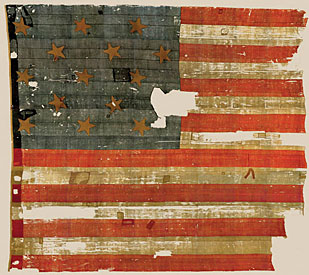
The original Star-Spangled Banner, the flag that inspired Francis Scott Key to write the song that would become our national anthem.
President James Madison, embroiled in a tight campaign for re-election, acquiesced to Congressional “war hawks” from the south and west and declared war on Britain in June 1812. Americans were emboldened by the fact that the British were deeply committed to a war with Napoleon Bonaparte that strained the resources of the crown. There was little acknowledgement in Washington that what passed for a standing army was only about half the size of Britain’s and stationed in widely scattered outposts; that the American Navy totaled about 50 ships to Britain’s more than 850; that coastal defense infrastructure was limited at best; and that there was no core of trained military officers to lead the poorly trained troops and militia. The British ships were much larger than their American counterparts.
Commercial and political interests in New York and New England, concerned about the potential destruction of shipping, opposed the war and in fact, continued to supply the British until the naval blockades were extended. Similarly, Britain saw America as an important market and supplier and only reluctantly responded to the declaration of war.
In the summer of 1812, American troops attempted to invade and conquer Canada. The poorly planned campaign ended in defeat and the withdrawal of the Americans. However, two American frigates, the USS Constitution and the USS United States, gained victories in naval battles, boosting American morale and contributing to President Madison’s re-election.
In response, the British gradually established and tightened a blockade of the American coast south of New York, impairing trade and undermining the American economy.
The attempts to invade Canada during the spring and summer of 1813 were somewhat more successful than the previous year’s, yet they ended in stalemate. By the end of the season, the British blockade had extended north to Long Island.
Remarkably, the young nation prevailed despite a long summer in the Chesapeake region. The British harassed citizens, burned towns and farms, and overwhelmed the scant American naval forces and militia. With the Americans distracted and largely unprepared, the British entered the nation’s capital and burned several public buildings, causing the President, his family and Cabinet to flee Washington. In September, however, an all-out land and sea defense of Baltimore forced the withdrawal of the British from the Chesapeake region. The same month, the British fleet in Lake Champlain was destroyed, leading to the British retreat into Canada. This defeat convinced the British to agree to a peace treaty, known as the Treaty of Ghent, with very few conditions. In January 1815, with neither side aware that the treaty had been signed the previous month, the British decisively lost the Battle of New Orleans. David had defeated Goliath.
The War of 1812 represents what many see as the definitive end of the American Revolution. A new nation, widely regarded as an upstart, successfully defended itself against the largest, most powerful navy in the world during the maritime assault on Baltimore and later at the Battle of New Orleans. America’s victory over Great Britain confirmed the legitimacy of the Revolution; established clear boundaries between eastern Canada and the United States; set conditions for control of the Oregon Territory; and freed international trade from the constraints that had led to the war. America emerged from the war with an enhanced standing among the countries of the world.
The war served as a crucial test for the U.S. Constitution and the newly established democratic government. In a bitterly divided nation, geographically influenced partisan politics led to the decision to declare war on Great Britain. Unprepared for war, under-financed, threatened by secession and open acts of treason, the multi-party democracy narrowly survived the challenge of foreign invasion.
Star-Spangled Banner Commemorative Coins
The 2012 Star-Spangled Banner Commemorative Coins are being sold by the U.S. Mint with the proceeds from the sales ($35 for each gold coin and $10 for each silver coin) to support the Maryland War of 1812 Bicentennial Commission.
-
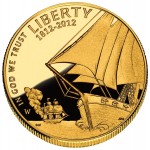
-
2012 Star-Spangled Banner Gold Commemorative Obverse depicts a naval battle scene from the War of 1812, with an American sailing ship in the foreground and a damaged and fleeing British ship in the background. Designed by Donna Weaver and engraved by Joseph Menna.
-
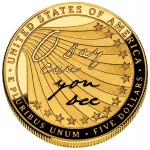
-
2012 Star-Spangled Banner Gold Commemorative Reverse Depicts the first words of the Star-Spangled Banner anthem, O say can you see, in Francis Scott Key’s handwriting against a backdrop of 15 stars and 15 stripes, representing the Star-Spangled Banner flag. Designed by Richard Masters and engraved by Joseph Menna.
-
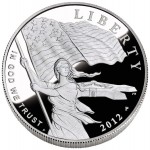
-
2012 Star-Spangled Banner Silver Commemorative Obverse depicts Lady Liberty waving the 15-star, 15-stripe Star-Spangled Banner flag with Fort McHenry in the background. Designed by Joel Iskowitz and engraved by Phebe Hemphill.
-
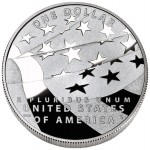
-
2012 Star-Spangled Banner Silver Commemorative Reverse depicts a waving modern American flag. Designed by William C. Burgard III and engraved by Don Everhart.
The commission will use these funds to support its bicentennial activities, educational outreach, and preservation and improvement of the sites and structures related to the War of 1812. Help support the commission’s activities by purchasing a commemorative coin today!
Jun 23, 2012 | Baltimore, commemorative, history
Following the end of the American Revolutionary War in 1783, Britain concentrated its efforts in colonizing Canada and defending itself in Europe. After the turn of the century, the British Empire was threatened by France with the rise of Napoleon Bonaparte.
As the new nation was forming and expanding, the British were also expanding and began to recruit Native American Tribes to agitate the Americans. The British were also hijacking American merchant vessels, many trading with France.
Some historians call War of 1812 the United State’s second revolutionary war. The primary reason for declaring war on Great Britain was after years of the Royal Navy harassing or capturing merchant ships bound for France. At the time, England was in the middle of the Napoleonic Wars and was trying to prevent France from getting the supplies it needed. This lead to President James Madison writing a letter to congress explaining England’s actions. Although Madison did not call for a declaration of war, the Democrat-Republican lead congress voted to declare war on Great Britain (79-49 in the House, 19-13 in the Senate). Madison signed the declaration on June 18, 1812. It was the first Declaration of War passed by the new nation.
To commemorate the bicentennial of the start of the what has been called America’s Second Revolutionary War, the Star Spangled 200 and the Maryland War of 1812 Bicentennial Commission held Sailabration in Baltimore’s Inner Harbor.
The week long celebration featured concerts, vendors, tours of Fort McHenry, tall ships, air show by the famous Blue Angels, and more.
As part of the celebration, the Star Spangled 200 organization was present to sell the 2012 Star-Spangled Banner Commemorative Proof Silver Dollar and promote the sale of the other options.
To assist the Star Spangled 200 organization and the coin clubs of Maryland, the organization invited the Maryland State Numismatic Association to set up a table on the side of their tent to promote the coin clubs of Maryland. MSNA and the Montgomery County Coin Club Vice President, your blog host, staffed the table on Sunday.
Aside from promoting collecting and the clubs of Maryland, I was also able to help talk with visitors about the 2012 commemorative coin to the various visitors. For seven hours, I stayed with the wonderful staff of the Star Spangled 200 organization talking with many visitors.
Jun 15, 2012 | coins, commemorative, commentary
Twenty-five years ago, on June 12, 1987, President Ronald Reagan stood in front of the Brandenburg Gate at the Berlin Wall and delivered a public message to Soviet Union leader Mikhail Gorbachev to remove the wall between East and West Berlin:
General Secretary Gorbachev, if you seek peace, if you seek prosperity for the Soviet Union and Eastern Europe, if you seek liberalization: Come here to this gate!
Mr. Gorbachev, open this gate!
Mr. Gorbachev, tear down this wall!
The iconic message to Gorbachev was proven prophetic as the Berlin Wall was torn down by the people of Berlin two years later.
Although I am not a fan of Ronald Reagan, I am a fan of history and iconic moments in history. Reagan’s speech that day in Berlin has to rank one of the iconic moments of the 20th century and should be remembered.
So why don’t we have some type of commemorative coin honoring this history?
The main reason what we do not commemorate major historical events is congress. Congress has taken its authority in the Constitution “To coin Money, regulate the Value thereof, and of foreign Coin, and fix the Standard of Weights and Measures” to a parochial degree. It does not say that congress designs the coins nor does it say that once the standards are set, the U.S. Mint could not issue different types of collectible coins based on those standard.
Maybe it is time to expand the role of the Citizens Coinage Advisory Committee to a real coinage advisory committee to recommend producing circulating and non-circulating legal tender coins. The concept of an advisory board to oversee this type of coin production is used in other countries like Canada and Great Britain. While the Royal Canadian Mint can be accused of abusing their authority, the Royal Mint does a better job at limiting the coinage and production to make real collectibles without too many gimmicks.
Using numismatics to honor history and those who made it is not a new idea. Educational Notes of the 1880s were printed with neoclassical allegorical images to represent themes that may have been out of reach for most people. While not popular at the time, the these notes are amongst the most desirable by collectors.
More recently, we have honored the 50 states; national parks and forests; the Louisiana Purchase and the Journey of Merriweather Lewis and William Clark; accomplishments of native Americans; and the Presidents of the United States on circulating coins. Lincoln was honored on the cent which bears his portrait before changing the reverse to honor the union he helped preserve.
Why not use our coinage to commemorate our history? Why not pick four significant events in history, one with a significant anniversary, and honor it on a circulating coin?
With the U.S. Mint looking for a way to increase coin collecting, which is their motivation for producing national parks business strike coins at the San Francisco Mint, why not use the reverse of the half-dollar as the canvas for a historical design series?
Prior to the production of the Kennedy Half Dollar, half-dollars were common circulating coins. Following the assassination of the popular president, people wanted to a souvenir of the slain president so when the new halves were released, the coins were hoarded and effectively ended the circulation of half dollars. Bringing back the half-dollar into favor would not only increase the number of people interested in collecting but the seignorage of these collectible coins would provide a windfall for the general treasury.
Rather than make just collectible business strikes at San Francisco, the new half-dollars struck at San Francisco would be added to the coins sold to the Federal Reserve for circulation. This could build interest in coins produced at the San Francisco Mint, increase production which will increase seignorage opportunities.
Adding the historical half-dollar reverse would introduce new themes that teachers could use to teach students about history, give collectors new outlets, and remind the rest of nation about the rich history that we pride as her citizens.
Of course the extra seignorage would not hurt, either.
Mar 9, 2012 | commemorative, news, US Mint
The following is the full version of the article that appeared in Numismatic News.
 Eighty-one years (and two days) after President Herbert Hoover signed he law that make “The Star-Spangled Banner” the United State’s official national anthem, the U.S. Mint and Maryland dignitaries came to Fort McHenry to launch the 2012 Star-Spangled Banner Commemorative Coin Program. The commemorative coins are designed to honor the role of the fort in the Battle of Baltimore and Francis Scott Key’s composing the poem after seeing the 15-star and 15-stripe flag still flying after an evening of bombardment by the British Royal Navy.
Eighty-one years (and two days) after President Herbert Hoover signed he law that make “The Star-Spangled Banner” the United State’s official national anthem, the U.S. Mint and Maryland dignitaries came to Fort McHenry to launch the 2012 Star-Spangled Banner Commemorative Coin Program. The commemorative coins are designed to honor the role of the fort in the Battle of Baltimore and Francis Scott Key’s composing the poem after seeing the 15-star and 15-stripe flag still flying after an evening of bombardment by the British Royal Navy.
During the march to Baltimore after the British attack on Washington, D.C., the British took Dr. William Beanes as a prisoner for his role in capturing British stragglers and deserters. Beanes was imprisoned in Baltimore as the Royal Navy gathered forces for their attack on Fort McHenry in Baltimore Harbor.
Word of Beanes’s capture reached Francis Scott Key, an accomplished lawyer, prosecutor, poet, and friend of Dr. Beanes. Key, who was known as a skilled negotiator and a very temperate man, was asked by the Army to accompany prisoner exchange agent Colonel John Stuart Skinner to Baltimore to secure the release of Dr. Beanes. On September 7, 1814, Key and COL Skinner dined with British officers abroad the HMS Tonnant to negotiate the release of prisoners. Although Beanes was released, the British would not let the men leave the ship because they had heard about the British plans to attack Fort McHenry.
That night, Key, Skinner, and Beanes watched as the Royal Navy bombarded the fort and surrounding areas of Baltimore. As the smoke cleared on the morning of September 14, 1814, after 25-hours of bombardment, Key was able to see the U.S. flag still flying over Fort McHenry. Key was so moved by the sight that after returning home, he wrote the poem “The Defence of Fort McHenry.” The poem was published in the Baltimore Patriot on September 20, 1814.
When the poem was published, it was noted that it could be sung to the music of The Anacreontic Song, the official song of the Anacreontic Society. Shortly after publication, the music and words were published together by Thomas Carr and renamed the Star-Spangled Banner.
Tina Orcutt, Superintendent of the Fort McHenry National Memorial & Historic Shrine, led the attendees in the Pledge of Allegiance to open the launch ceremony. After her welcome message, Baltimore’s WBAL reporter Sarah Caldwell took over as master of ceremonies to introduce the dignitaries. Senator Ben Cardin spoke on how he helped push the bill through the senate with the chiding from Rep. C.A. “ Dutch” Ruppersberger who sponsored the original bill. Rep. John Sarbanes, whose district includes Fort McHenry, spoke next and Maryland Governor Martin O’Malley followed. The program concluded with a few words from U.S. Mint Chief Counsel Daniel Shaver to open the sale of the coins.
Waiting in line to purchase the silver proof coin following the ceremony was Melissa, a paramedic from Orlando who was in Baltimore for training. She was with her family visiting Fort McHenry not knowing about the launch ceremony. When asked about the ceremony, she said, “I thought it was very professional. It was awesome. It was moving very moving.” After purchasing the coin Melissa and her family toured the new Visitor Center before visiting the fort.
Richard Hughes came to the ceremony from Annapolis, the state capital for the launch. He was asked about the silver coin he was about to purchase and said, “I like it. It’s provocative. I think they did a good job.” Several people standing nearby in the line agreed.
Also attending was Shaun Butcher who came from Frederick, Maryland “to be one of the first to buy [the coin] when it was released,” noting Frederick was Francis Scott Key’s hometown. “I think the design is unique in terms of highlighting the War of 1812 and the Star Spangled Banner,” Butcher said. “We should be proud a Marylander wrote the National Anthem.”
Butcher is a member of the Frederick Arts Council and is an elected board member of the Frederick Tourism Council. He boasted how Frederick is part of the War of 1812 Bicentennial celebration organized by the state and that Frederick is planning an additional celebration to honor Key’s writing of the poem to take place in September 2014.
The 2012 Star-Spangled Banner Commemorative Coins are available as $5 gold coins and $1 silver. Both can be purchased as uncirculated or proof coins from the U.S. Mint. Surcharges collected from sales of these coins, $35 for the gold coin and $10 for the silver coin, will be paid to the Maryland War of 1812 Bicentennial Commission to support the celebration that will last through 2014.
Image of original manuscript of “The Defence of Fort McHenry” courtesy of Wikimedia.
Mar 5, 2012 | Baltimore, celebration, commemorative, news, US Mint
Today, March 5, 2012, the 2012 Star-Spangled Banner Commemorative Coins will go on sale with a launch ceremony at the the Fort McHenry National Monument and Historic Shrine. Program is scheduled to begin at 11:00 A.M. at the Visitor Center and sales to begin at 11:30 A.M.
According to the media release from Maryland War of 1812 Bicentennial Commission, the group organizing the bicentennial of what historians consider America’s second revolutionary war against the British, “Those who purchase a coin that day will receive a Certificate of Authenticity from the United States Mint and a special acknowledgement from the Maryland War of 1812 Bicentennial Commission.”
In addition to the coin sales, specially made chocolate versions of the coins will be offered by Kirchmayr Chocolatiers, a Baltimore company specializing in fine European chocolate.
If you cannot make it to Baltimore for the launch, fear not! Your intrepid blogger will be making the trip, camera and iPhone in hand. As part of the trip, I will be live tweeting on Twitter from Baltimore. Follow me @coinsblog to read about the ceremony and see some the pictures I take. I plan to shoot video of the ceremony and will post an edited version later this week.
 Did You Know?
Did You Know?
Fort McHenry was built prior to the War of 1812. The fort is named for
James McHenry, Secretary of War, 1796-1800.
Fort McHenry aerial image and nugget courtesy of the National Park Service.
Feb 6, 2012 | coins, commemorative, video
Your blog host is happy today as his favorite team, New York Giants, lead by MVP Eli Manning, beat the New England Patriots in Super Bowl XLVI. As a die-hard Giants fan, I worried if the team that was dominated by the 5-11 Redskins in Week 16 would show up or would the run that started the next week against the Jets continue. Like every game in the run, the Giants did just enough to hang in before putting the ball in Eli’s hands to let him do his magic.
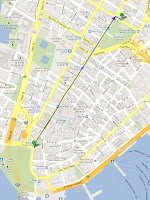 Next stop for the Giants is a ticker-tape parade down the Canyon of Heroes on Tuesday February 7. The Canyon of Heroes is the section of lower Broadway in the Financial District that runs from Bowling Green to City Hall Park.
Next stop for the Giants is a ticker-tape parade down the Canyon of Heroes on Tuesday February 7. The Canyon of Heroes is the section of lower Broadway in the Financial District that runs from Bowling Green to City Hall Park.
The game started like every other football game does with the coin toss. For the last 21 Super Bowls, including Sunday’s Super Bowl XLVI, the Official Coin used for the coin toss is made by The Highland Mint of Melbourne, Florida.
You can find out more about how the coin is made complements of FloridaToday.com:
The Highland Mint strikes 10,000 coins and are numbered. The first 100 are sent to the NFL where number 1 is used for the coin toss. After the game, it is sent to the Pro Football Hall of Fame in Canton, Ohio.
In the following video, you can see more of the manual aspects of the minting process, including the gentleman sitting at a machine that stamps numbers into the coins which is shown in the second-to-last scene.
If you are a member of the Papa Rewards Program, the loyalty program for Papa John’s Pizza, your interest in the coin toss ended when it landed on heads and you won a free pizza and soda. Enjoy your pizza!
Jan 5, 2012 | coins, commemorative, legislative
Commemorative coin programs are known to be able raise a lot of money for many organizations. This past year, congress authorized commemorative coins to support the Congressional Medal of Honor Foundation and the construction of the National Museum of the United States Army at Fort Belvoir. These and other organizations have greatly benefitted from collectors and other interested people buying commemoratives.
With that in mind, Dave Harper of Numismatic News has suggested that commemorative be issued to repair the Washington Monument that was damaged during the earthquake in the Washington, DC area on August 23, 2011.
Dave reports that $7.5 million was appropriated to the National Parks Service with hopes that it could be equally matched with private donations.
In 1986, the Statue of Liberty commemorative raised $81 million for the repairs needed before her 100th birthday. Why not do the same for the Washington Monument?
Harper suggests that the Washington Monument may not generate as much interest as the Statue of Liberty. That may be so, but why limit the the program to just the Washington Monument? How about a The National Monument Commemorative Coin Act of 2012?
The National Monument Commemorative Coin Act of 2012 will honor all of the United States’s national monuments, the U.S. Mint would issue one silver dollar commemorating all national monuments and five half-dollars commemorating various national monuments. The silver dollar could use the logo of the National Park Service that manages 76 of the 101 registered national monuments. As for the half-dollars, the suggested national monuments could include the Washington Monument, Mount Rushmore, the boyhood home of George Washington Carver, the Great Sequoia in Sequoia National Park, and the Navajo Monument on the Shonto plateau
Proceeds from the surcharges collected by the sales of these coins would be placed in a trust fund managed by the Department of the Interior that could only be used for the maintenance of all national monuments, including the Washington Monument.
If you think this is a good idea, please let your member of congress know. You can find your representative at the House website by entering your zip code +4 in the box on the upper right of the page. Use any of the information mentioned above to tell them how good of an idea this is.
Dec 16, 2011 | commemorative, US Mint
If you have not purchased your 2011 commemorative coins, you have until 5:00 P.M. Eastern Time to place your order before the U.S. Mint takes the coins off sale. For 2011, the two commemorative programs are for the Medal of Honor and the U.S. Army. Both programs feature a proof and uncirculated $5 gold coins, silver dollars, and clad half-dollars.
Surcharges for both programs are $35 for each gold coin, $10 for each silver coin, and $5 for each clad coin. For the Medal of Honor Commemorative, the surcharge will be paid to the Congressional Medal of Honor Foundation. Surcharges collected for sales of the U.S. Army Commemorative will support the construction of the National Museum of the United States Army at Fort Belvoir, Virginia.
The U.S. Mint reports that there are plenty of coins available. To purchase the coins, visit the U.S. Mint online catalog at catalog.usmint.gov.
 The White House announced today that President Obama signed the National Baseball Hall of Fame Commemorative Coin Act into law (H.R. 2527). The law calls for the U.S. Mint to commemorate the the National Baseball Hall of Fame in Cooperstown, New York with a three-coin commemorative program consisting of a $5 gold coin (50,000 maximum mintage), $1 silver coin (400,000 maximum), and a clad half-dollar (750,000 maximum) struck as uncirculated coins or as proofs.
The White House announced today that President Obama signed the National Baseball Hall of Fame Commemorative Coin Act into law (H.R. 2527). The law calls for the U.S. Mint to commemorate the the National Baseball Hall of Fame in Cooperstown, New York with a three-coin commemorative program consisting of a $5 gold coin (50,000 maximum mintage), $1 silver coin (400,000 maximum), and a clad half-dollar (750,000 maximum) struck as uncirculated coins or as proofs. 




 ,
, 





